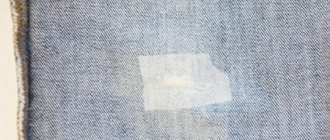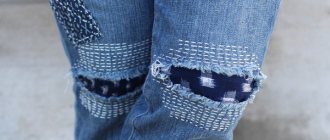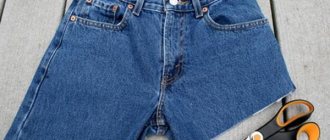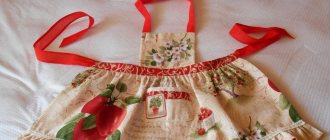Hole in jeans, how to sew up jeans without a patch
Manual darning of jeans is suitable if the tear is along one line or at a right angle (other types of darning are suitable for other types of fabric damage). To do this, you need to choose a thread color that is as close as possible to the color of the fabric.
- We lay the stitches from one side to the other.
2. Through the stitches that are stitched, we direct the needle and thread, perpendicularly, passing through the already stitched threads from above and below.
3. This is what it should look like
How to sew on a knee
If a section of tissue on the knee is damaged, there are two repair options:
- Classic darning of jeans. For this you need special threads, scissors, a thick needle, and a thimble if possible. The cut or tear is sewn up with tight and small stitches, first in a horizontal and then in a vertical position;
- Decorating a cut or hole. For this you need appliqués, threads, a needle, a thimble, an iron, scissors, and thermal tape. The process is as follows: an applique is applied to the hole and ironed well. If the design does not have its own adhesive base, then you need to “plant” it on special glue or thermal tape. To prevent the applique from falling off during wearing or washing, you can sew it on with threads.
You might be interested in this: The procedure for sewing blankets and other clothing for cats
Embroidery can also save pants
Patch on jeans on knees
Decorating a hole in the knee is very simple. In the old days, such patches spoke of poverty, but today the situation has changed. A patch on the knee will add a special chic to your jeans. Moreover, it can be placed both on a real hole and on new jeans. This will be an individual haute couture piece. You will not see such a thing anywhere. Women, men and children can “revive” jeans and give them originality. Of course it is possible. Give your jeans a fashionable look by making holes in other places. But not everyone is happy with this look.
how to install manually, master class
Not all holes can be mended by hand. Horizontal cuts are suitable. To do this, sew with dense and small stitches. There is no need to rush in this matter. Try to make stitches evenly, leaving a minimum distance between stitches.
To mend jeans by hand at the knee, use the Sashiko technique.
To darn jeans by hand at the knee, use the Sashiko technique. This is a Japanese method that is characterized by punctures in the fabric.
Prepare everything you need.
- Special thread for “sashiko” (if you don’t have it, use floss).
- Scraps from old clothes.
- A thimble or a special ring.
- Pins, chalk, ruler, marker.
Select pieces of fabric, cut to the size of the hole, adding 3 centimeters. Insert inside the pant leg.
Make sure the patch fits exactly under the hole. Keep in mind that the patch should sag a little so that you can bend your knee. Secure with pins and then baste. Use a ruler and marker if you want to make a specific stitch or pattern.
Use a needle with a wide eye, as the embroidery thread will easily pass through it.
Keep your stitches short on the right side and long on the back.
Having gathered the fabric onto the needle like an accordion, pull the fabric further.
The next line goes in the opposite direction.
A thimble or a special ring will help push the needle.
Make stitches on the other side of the patch.
For originality, you can sew on a piece of fabric.
Ready!
There are a lot of options for decorating knees. You just need to use your imagination
Patches placed on the inside and sewn by hand.
Lace patches are suitable for a young girl. They are applied from the inside. You can use adhesive tape. A seam is laid along the edge, using threads to match the jeans.
how to install on a typewriter, master class
Using a sewing machine to mend a hole in a knee is not so easy. To do this, you need to rip the trouser leg along the seam (it is advisable that the seam is not finished with decorated stitching).
- On the machine, set the stitch to a straight line.
- Bring the two cut edges together, close together, and stitch.
- Steam with an iron (this will make the darning less noticeable).
- Overlay seams parallel, close to each other.
- Start stitching one centimeter from the hole.
- Place seams back and forth, turning the stitching in reverse or turning the product over.
- Continue stitching until the hole is sealed.
Patches placed on the front side using adhesive fabric. To sew such a patch on the knees, rip both pant legs on one side. We sew the edges on the machine from the front side.
Patch with “mohra”
- Prepare a piece of denim that should be two centimeters larger than the hole, on all sides. place it on the area where the fabric is torn (above).
- Place adhesive fabric on top, even larger than the patch.
- Place another piece of thin fabric on the adhesive fabric, spray with water and iron.
- Take threads to match the jeans and sew with a zigzag on the front side.
- Cut off the remaining protruding threads.
Any place on jeans can be disguised using applique...
Instructions for proper stitching
If a person has never darned holes in his pants, then it would be ideal to read the instructions on this matter. One of them will be presented below. Having completed all these points, you can easily learn how to sew up a hole in your pants unnoticed. Actually instructions:
- Choose threads whose color should be invisible against the background color of the fabric. You should also choose the right and thick needle. Thin and small needles are not suitable for denim;
- Thread a thread through a needle and tie a knot at its end, or better yet several knots in one place;
- Sew the hole from the wrong side, tightening the thread as tightly as possible. You need to sew close to the edge of the seams of the holes;
- During the darning process, you should constantly look at the front side of the fabric so that the seam is smooth and beautiful;
- Make a few additional knots so that the seam does not come undone when worn, and cut off the rest of the thread.
You might be interested in Creating an organizer for threads and sewing tools
Darning technique
We sew by hand
If the hole turns out to be a straight or angular cut, then you can simply and efficiently darn on a sewing machine, for example, the popular Janome. To start the process, you need to choose the color and shade of thread that is suitable for darning jeans. Next, you need to make several stitches, which should be the same in size, as well as the tension of the individual threads. If these rules are not followed, the torn hole will look worse than before repair. It turns out that sewing up a hole in jeans without being noticed is quite simple.
Torn knees with torn edges
Important! If we are talking about repairing children's or women's clothes, then you can apply appliqués, patches on top, or decorate the repair as an element of clothing design.
Applique on pocket
How to sew without a machine
The easiest way to sew up any type of hole in jeans without using a sewing machine is to simply darn or apply a patch. You can create decor around and on the hole not only with the help of various denim and non-denim fabrics and buttons, but also with other accessories and ribbon. It is better not to repair children's and thin pants in this way, since the hole may tear even more, but use hand sewing on a piece of other denim. In general, the same instructions described above will work for mending a hole.
Hand stitching technique
DIY patch on jeans, step by step with explanation
We will need:
- A piece of suitable fabric.
- Adhesive tape (you can do without it)
- Thread number 35.
- Scissors.
- Pins.
- Chalk or bar of soap.
Depending on the nature of the fabric tear, the darning method is chosen. If you don't want to decorate your jeans with colorful appliques or fabric, the "stuffing" method is for you.
“Putting” is a method of restoring damaged fabric using stitches on a sewing machine.
For example, let's take gray jeans that have frays in different places.
Abrasion at the bottom of the pocket
Hole near the pocket
Soreness in the groin area
In total, there are four places on the jeans where patches need to be placed.
Patches for the areas shown in the first two photos. We cut out circles, a little larger in size than the abrasions, and process them with an overlocker. The wrong side will be used.
We cut out one patch for the abrasion between the legs and also process it with an overlocker.
We rip open the patch pockets, the thing will go under them.
We use adhesive web and glue it to the required places with an iron.
Since, usually, the color scheme of jeans has a heterogeneous structure, we select threads for each place.
Set the screed size to small. Where there are abrasions, we make the “piece” not tightly, using a zigzag stitch, trying to follow the inclination of the fabric hem in order to preserve the design.
The right pocket is a loose “thing”, the seam is not directed in the direction of the fabric hem, since in this place this method will be less noticeable.
Between the legs, the “stuffing” is made more dense to avoid fraying. Places nearby are covered with a light “stuffing”, where the fabric is already thin, but has not yet worn out.
When making a tight piece, make the lines perpendicular to the gap. We apply a thick “stuff” only in places where there is a tear, without catching the fabric nearby, so that there is no thickening nearby.
Patch on jeans on the butt, how to do it beautifully
The buttocks are the place that attracts attention. Several patches are placed here, even in places where there are no holes. Since one patch suggests that it was placed specifically to close the hole. Appliques or embroidery made from thick threads are used. Place the patches randomly, so the jeans will look creative. Embroidery can be done on a sewing machine, if it has such a function, or manually, but for this you need to have skill, or you can embroider a piece of fabric, cut out the embroidery along the contour and glue it to adhesive tape.
Why do my jeans rub between my legs?
There are several reasons for the appearance of scuffs and holes in jeans between the legs:
- Body shapes. Excessive volume in the hip area, which appears due to heavy weight or increased muscle mass, leads to strong tension in the tissue during wear. In addition, with voluminous thighs, the gap between the inner thighs usually disappears, which leads to pant legs rubbing against each other along the entire length of the thigh.
- Way of walking. A gait in which the legs touch each other on the inside. In this case, the fabric can be rubbed both in the crotch and in the knees.
- Textile. The thicker the fabric, the less one is exposed to external loads. Artificial threads of elastane or polyester make the material stronger. While jeans made from thin denim will not have a long service life, especially if there are other reasons that contribute to the wear of the trousers.
The reasons for jeans rubbing between your legs can be different - from excess weight to poor fabric
- Sedentary work. Sitting still for hours is difficult, so the average person fidgets in his chair from time to time, shortening the life of his jeans.
- Errors when washing. Denim should not be washed in very hot water. Recommendations given by the manufacturer and on the label should be taken into account. If such information is not available, then the water temperature should not be higher than 45°C.
You also need to make sure that when drying, the pant legs are turned inside out and are not exposed to direct sunlight.
In order for jeans to last a long time, even at the purchase stage you should be guided by certain selection rules:
- Tight models wear out faster. Therefore, it is better to opt for more spacious pants.
- Jeans with a high waist or a standard height are more wearable. This is due to their better fit to the body and uniform distribution of load on the fabric. Conversely, models with a low waist will rub in the crotch faster.
- For sedentary work, it is recommended to choose thick denim trousers. And also knowing about the problem of abrasion, you should control your own movements as much as possible. For example, do not “ride” your heel on the chair, but stand up if you need to reach something or bend over.
- It is advisable not to let jeans appear until holes appear. As soon as abrasions and thinning of the fabric become noticeable, measures should be taken immediately - strengthen the fabric.
Invisible patch on jeans, tips
- To make the stitching less noticeable, you need to choose the right thread. This can be done at a sewing store, taking the jeans with you.
- Choose the following thread numbers - from 35 to 45.
- To prevent the fabric from stretching when darning, when sewing on a machine, do not stretch the fabric too much.
- If you can't find the right fabric for the patch, use the space under your pocket. To do this, open the pocket, cut the desired size of fabric and sew the pocket in place.
- If your machine does not have a reverse stitch, after finishing the stitch, turn the fabric over in a circle.
- Select the fabric for the patch, depending on the thickness of the fabric. Thick material is not suitable for thin summer jeans.
- Steam the patch using the iron function - cotton + steam.
- Don't throw away your old jeans, you'll need them for patching your favorite things.
- Lace decor on women's jeans - black is suitable for dark pants, white for light ones.
- The “Retro” style can be created using patches made of checkered fabric.
Leather patches for jeans, tips
Another type of patches for jeans is leather. They are very practical and look impressive. Old leather jackets, gloves and even boots can serve as material for a leather patch. In this case, you can cut out any shape in the form of a flower or geometric figure. Eco-leather patches are sold in sewing stores and online stores. They have special holes to make it convenient to sew them on by hand. Use leather patches on your knees or other places, they are quite durable and will last a long time. The location of such a patch can be at your discretion, the main thing is that it covers the hole and there is a margin of at least one centimeter. Prepare a thimble so that you can press on the needle comfortably. Place the jeans on a flat surface and apply a leather patch to the tear. Using suitable threads, sew on to match, sticking a needle into the holes.
How to make ripped jeans?
Most girls probably have a couple of decent denim trousers lying around that they can freshen up and transform on their own, at home. Making ripped jeans at home is quite easy.
Prepare tools for work. Only scissors will not be enough, so you may have to go to the nearest sewing store and buy:
- sewing chalk or a regular thin piece of soap. You will need to mark where and what size the cuts will be. You can use other light coloring agents that are easy to wash off;
- darning needle. To form a voluminous fringe;
- cutting board. It is designed to protect the back of the trouser leg from damage. In principle, there is no particular need to buy a board if you have clean cutting board or thick, uniform plywood;
- sandpaper (in a hardware store) or pumice (in a household chemicals supermarket). Great for minor to severe abrasions;
- tweezers or thin tongs - for pulling out individual threads;
- chlorine liquid or bleach. For highlighting fringes, threads around rips, etc.;
- sponge;
- stationery knife. A tool that can be used to make even or uneven cuts in fabric. If this is not available, you can use a very sharp blade, scissors or a sharpened knife.
Beautiful cuts, releasing fringes, pulling threads, cutting off large pieces of fabric - everyone can make a beautiful version on their own.
For any option for creating holes and abrasions, it is important to do the following steps:
- Use paint to mark the location of the hole or abrasion.
- Place a piece of flat, hard material inside the leg that will protect the back of the jeans.
Here you need to look at a photo to see which version of holey jeans will look great: many small ones or several large ones, multiple abrasions, or stretching of long threads. There are several options for making holes in jeans.
First way:
- make even horizontal and/or vertical cuts in the right places according to the intended idea. It is best to use a utility knife;
- Using a darning needle or something sharp, pull out the light threads, and simply pull out the dark horizontal threads with tweezers.
Second way:
- make the necessary cuts according to the general concept;
- remove longitudinal threads with a regular stationery knife;
- tear off or cut off excess threads;
- make light scuffs with bleach;
- Leave the trousers for a few hours and then wash them.
You can find many options for creating a torn effect, with photo and video instructions.
How to make scuffs on jeans? Prepare all the same tools as for creating holes. Procedure:
- Place a hard, flat surface inside the leg;
- Mark all places with chalk where there will be abrasions;
- Using sandpaper or a regular grater, start moving it in the desired direction along the fabric. Stop when you reach the desired texture;
- Tear several places at different points, and/or pull out the threads with a darning needle so that they stick out.
But how to make holes in the knees? Very simple:
- Put on jeans and mark with chalk horizontal stripes where the cuts should be;
- Insert the board into the pant leg and make a cut with a utility knife;
- Use tweezers to get rid of unnecessary threads;
- Lightly rub the edges of the cut with sandpaper;
- If desired, soak the edges a little with bleach, which must then be washed off in the wash.
Below is a video life hack on how to make ripped jeans with your own hands.











